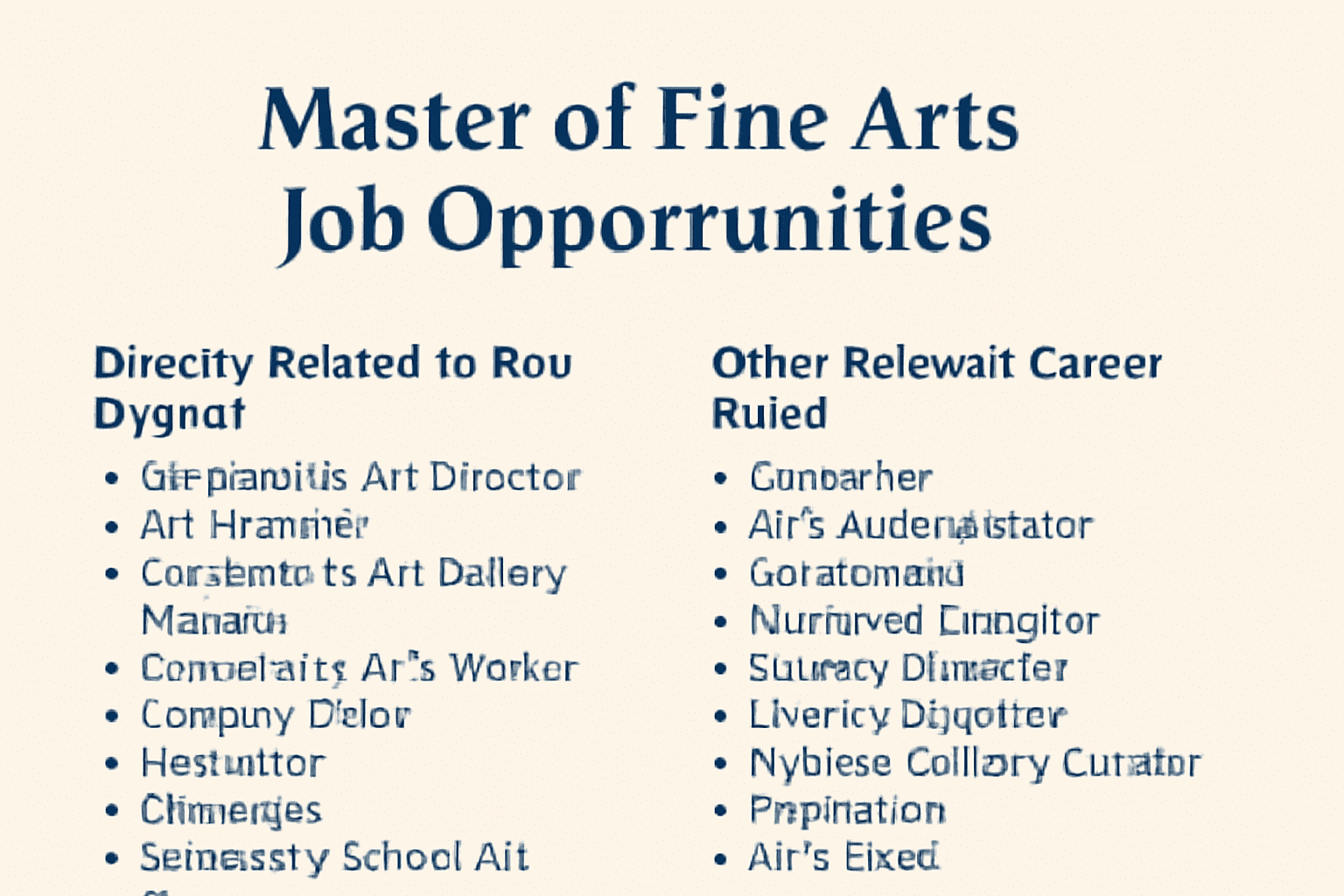Introduction
For aspiring artists and creatives, an Master of fine arts offers the job opportunity to refine technical skills while honing artistic vision. While most MFA graduates pursue careers within the arts, the flexibility and creativity embedded in this degree often lead to diverse career paths. From art direction to teaching and curation, MFA Employment opportunities support a variety of talents and interests.
In this article, we’ll take a deeper look at some of the key career options for MFA graduates, along with valuable tips for making the most of your degree.
Top Master of Fine Arts Job Opportunity for Graduates
Directly Related to Your Degree
MFA graduates can pursue a variety of job roles directly aligned with their degree. Below are some of the top job opportunities:
- Advertising Art Director: Lead creative teams in designing visual concepts for advertising campaigns, branding, and media outlets.
- Art Therapist: Use art as a therapeutic medium to help individuals express emotions and work through psychological challenges.
- Commercial Art Gallery Manager: Manage the operations of art galleries, from curating exhibitions to overseeing sales and marketing.
- Community Arts Worker: Collaborate with communities to create art projects that promote social engagement and creative expression.
- Concept Artist: Work in industries like gaming or film to create visual concepts for characters, environments, and scenes.
- Fine Artist: Pursue a career in painting, sculpture, or other forms of visual art, showcasing work in galleries or through private commissions.
- Illustrator: Create visual representations for books, magazines, advertisements, or digital media.
- Secondary School Art Teacher: Teach art to high school students, fostering creativity and skill development.
Other Relevant Career Paths
Beyond roles directly tied to the MFA degree, there are other professions where your skills will be highly valuable:
- Artworker: Provide creative support in industries like publishing, design, and marketing.
- Arts Administrator: Manage art institutions, from theaters to nonprofit arts organizations.
- Conservator: Focuses on the rehabilitation and maintenance off artworks, ensuring their longevity for future generations.
- Exhibition Designer: Design the layout and visuals for art exhibitions in museums, galleries, or events.
- Graphic Designer: Create visual content for print or digital platforms, blending design with artistic principles.
- Jewelry Designer: Craft custom or mass-produced jewelry, often combining artistic flair with craftsmanship.
- Museum/Gallery Curator: Oversee art collections and curate exhibitions, managing acquisitions, displays, and educational programs.
- VFX Artist: Works in film and video games to create visual effects, combining art and technology.
While these are just a few examples, remember that many employers value the creativity and problem-solving skills developed in MFA programs, meaning that graduates can choose their careers in a wide range of fields as well.
Essential Skills and Experience for Success
In addition to technical proficiency in your artistic medium, MFA graduates must develop a diverse set of transferable skills. Some of the most important skills include:
- Creative Problem-Solving: Ability to think outside the box and overcome challenges with innovative solutions.
- Project Management: Organize and execute projects from inception to completion while meeting deadlines.
- Collaboration and Communication: Work effectively with others, whether in a team environment or with clients and galleries.
- Marketing and Self-Promotion: Skills in self-promotion and entrepreneurship, including managing your own art business.
- Attention to Detail: A careful attention to detail that makes your work better and ensures perfection in execution.
Employers seek candidates who are not only talented artists but also strategic thinkers and strong communicators.
Work Experience and Portfolio Development
Building a robust portfolio is essential for securing employment as an MFA graduate. Your portfolio should showcase your originality, imagination, and ability to work with diverse styles. Including work outside of academic assignments, such as personal projects or commissions, will demonstrate your ability to work independently and have master of fine arts offers the job opportunity.
Networking and Exhibitions: Attend art exhibitions, fairs, and networking events. Engaging with fellow artists and industry professionals can help you gain recognition and potentially lead to contract work or full-time opportunities.
Internships and Voluntary Work: Gain experience by applying for internships or voluntary positions within art galleries, museums, or art-related nonprofits. This exposure can lead to paid employment and provide valuable learning experiences.
Networking and Building Industry Connections
Networking is critical for any creative professional. MFA graduates should focus on building meaningful relationships within the art community. Here are some networking strategies to consider:
- Collaborate with Peers: Work with other artists on joint projects or exhibitions.
- Engage with Industry Professionals: Reach out to curators, gallery owners, and industry leaders to seek guidance and job opportunities.
- Social Media Presence: Utilize platforms like Instagram and LinkedIn to showcase your work, connect with industry professionals, and engage with potential clients.
Remember that networking isn’t just about gaining immediate opportunities. It’s about building relationships that will support your career over the long term to get master of fine arts offers the job opportunity.
Typical Employers and Industries
While pursuing a career as an independent artist is possible, many MFA graduates work within institutions, galleries, and businesses that support or collaborate with the arts. Typical employers include:
- Advertising Agencies
- Art Galleries and Museums
- Design Studios and Agencies
- Nonprofit Organizations
- Educational Institutions (Primary and Secondary Schools, Universities)
- Corporate Art Departments
- Film and Video Game Production Studios
- Freelance and Self-Employed Opportunities
Each of these sectors offers unique benefits, from creative freedom in the art world to the stability of corporate or educational roles.
Further Study and Career Advancement
An MFA is often just the beginning of a lifelong journey in the arts. Graduates may choose to continue their education with specialized programs or certificates in fields such as:
- Art Therapy
- Art Conservation
- Arts Management
- Illustration or Digital Arts
Further study can enhance specific skills, broaden your professional expertise, and open up new career paths. Many MFA graduates also pursue teaching roles at the college or university level, where they can inspire the next generation of artists.
Conclusion
A Master of Fine Arts degree offers a wealth of job opportunities across various industries, each allowing graduates to showcase their creative talents and passion. Whether you’re pursuing a career as a fine artist, educator, or art director, there are numerous paths to explore. Building a strong portfolio, gaining work experience, and networking within the industry are crucial for success. The MFA journey is about more than just earning a degree and it’s about establishing a lifelong career in the arts, where creativity and skill can make a lasting impact.






